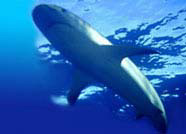


Shark Info Sheet

 |
 |
 |
|||
| Home | Evolution
| Classification
| Glossary | Biology
| Behavior | Shark
Repellent | Shark
Conservation | Do's &
Don'ts | Did You Know?
Shark Info Sheet |
 |
||||
|
Basking shark
 Scientific
name: Cetorhinus maximus Scientific
name: Cetorhinus maximusBasking Sharks are the second largest fish in the sea, second only to the Whale Shark. They were once hunted for their liver oil but are now considered vulnerable. The basking shark is also called the sunfish, the bone shark, the elephant shark, the sailfish shark, and the big mouth shark. Basking sharks are a deep blue-charcoal color with a pale belly and two distinctive, dissimilarly sized dorsal fins. They are easily distinguished by their large gaping mouths and bristle-like gill rakers, which they use for feeding. The gill rakers are 1m long and are shed in winter, in time for the spring plankton bloom. They have small, very reduced teeth - about a hundred per row. The basking shark may be huge in size, however it feeds on one of the smallest creature of the ocean- plankton. These are very slow swimmers travelling at 5kmph and usually open their mouth as they drift and filter the plankton by expelling excess water through their gill rakers trapping food particles. Gill rakers are bristly structures (the thousands of bristles are about 4 inches or 10 cm long) in the shark's mouth that trap the small organisms which the shark then swallows. The water is expelled through the shark's 5 pairs of gill slits. The shark can process over 1500 gallons (6000 liters) of water each hour. They take in an estimated 1,482,000 litres of water an hour, using more than 5,000 gill rakers to strain the food. In winter, they lose their gill rakers, which suggests that they cannot feed during this time. A basking shark can live up to 50 years and inhabit the regions of North and South Atlantic and pacific oceans, regularly visiting European Coasts. Basking sharks are found off the coasts of western North America from Baja to southern Alaska, off the east coast of the US and southern Canada, along the Gulf Stream, to the entire coastline of Europe, off the southern coast of Australia, off South Africa, New Zealand, most of southern South America, the Red Sea, and the coastlines of China and Japan. They inhabit the surface waters of the open sea and coastal waters where they breed in the summer. These are usually found in-groups of 3-4 or pairs, although a group of 100 have been recorded. They migrate according to the seasons, feeding in cool northern water and moving towards south towards winter. The Basking sharks reproduce by a process called Ovovivipary. The young develop in the eggs when inside theirmother's womb and hatch as soon as they are released from her body. At birth, they are about 1.5 meter long, the largest pup of any shark. Like all sharks, fertilization of the eggs occurs within the female. The eggs hatch within the female and are nourished by eating unfertilized eggs in the womb. There is no placenta to nourish the babies - they must fend for themselves, even before birth. They swim away from the mother immediately after birth, there is no maternal care-giving. Basking sharks have a slow growth rate, lengthy maturation time and long ges  tation
period (as much as 3.5 years). In the past, they were hunted extensively
for liver oil and fins. The number of basking sharks left today is unknown.
In 2002 they, and the related whale shark, were added to the Convention
on International Trade in Endangered species of Wild Fauna and Flora (CITES)
Appendix II, meaning that trade in their products will be tightly controlled.
The IUCN Red List of endangered animals cites them as vulnerable. tation
period (as much as 3.5 years). In the past, they were hunted extensively
for liver oil and fins. The number of basking sharks left today is unknown.
In 2002 they, and the related whale shark, were added to the Convention
on International Trade in Endangered species of Wild Fauna and Flora (CITES)
Appendix II, meaning that trade in their products will be tightly controlled.
The IUCN Red List of endangered animals cites them as vulnerable. Statistics: The largest recorded basking shark was 12.3m, but on average females is 8.9m and males are 6.5m. Basking sharks are the second largest fish in the world, weighing about 4 tons. Basking Shark Classification:
|
|||||
| Sitemap | Reach To Us | Jimtrade - Business Directory of India | |||||